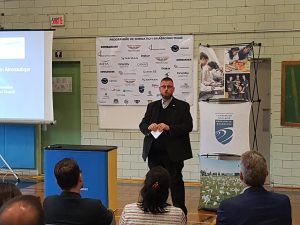St. Laurent, QC – Thanks to the financial participation of Bombardier Aerospace, St-Laurent Economic Development and the International Association of Machinists and Aerospace Workers (IAMAW) as well as many partners, students from St-Laurent High School will benefit, starting this fall, from the extracurricular Aeronautical Training Program (ATP), provided at no charge during the entire school year.
Forty-five students at St Laurent will soon learn to fly on a flight simulator and create their own model aircraft during their lunch breaks and after school. The goal is to stimulate interest in science and ultimately to fill jobs in aerospace.

“Reducing school dropout and improving our education system is a great way to build a more just society. If aerospace workers and the Machinists Union can play a role, why not, says the IAMAW Quebec Coordinator, David Chartrand. “At the Union of Machinists, servicing the community has always been part of our values. This is why we want to help Aviation Connection.”
Investing in the future of our young people is the goal of ATP partners: The ATP allows students to acquire STEM (Science, Technology Engineering and Maths) knowledge, needed to face the challenges of the 21st century economy, versed in science and digital technology. AERO LAB in the School: unique in North America!
AERO LAB in the School: unique in North America!
The ATP was implemented in the Massey-Vanier High-School, Cowansville in January of 2018. Today, 5 schools offer the ATP in Québec. The AERO LAB in 5 schools will reach more than 5000 students throughout the school year. A major player in Québec education, the Marguerite-Bourgeoys School Board, made up of 100 institutions with some 71,000 students, stands out in its innovative initiatives to ensure student’s success. The CSMB, is one of the most multi-ethnic school boards in the province: 63% of its students do not have French as their mother tongue, yet the CSMB has a record graduation and qualification rate of 85.9 %. Diane Lamarche-Venne, president of the CSMB, can be proud of these results. The CSMB does not hesitate to deploy winning strategies to support its teachers and students and stay on course!
Located at the center of a major aeronautical sector, St-Laurent borough, one of Québec’s leading Industrial Poles, recognizes the benefits of the program especially in the promotion of careers in the aeronautics sector to high school students. In short, the Aerospace Training Program (ATP) consists of five levels of courses provided over three years. Students are called upon to perform mechanical and structural transformations on virtual aircraft that they first learned to fly. In all, eight Simulation Stations are installed in THE ‘AERO LAB’ located in the school. Year 2, 3, 4 students develop an interest in designing and manufacturing aircraft with the construction of an unmanned model and participate in a competition. The spirit of entrepreneurship is developed through the management of an aircraft restoration project donated by Aviation Connection. The project is spread over 3 years.
“The activities we offer are challenging, and they draw on the knowledge gained in many subjects. Bringing the complex and abstract formulas that we find in science or mathematics to something concrete like flying or assembling an airplane makes learning easier and more interesting “says Camil Dumont Aviation Connection, president and founder.
Recognizing the problems
- Shortage of manpower
- Lack of enrollment in technical schools – ÉNA, EMAM
- Within ten years, 40 per cent of the aeronautic workforce will retire
- Serious shortage of pilots
- Low graduation rates for high school boys
Fostering academic perseverance and attracting young people to the aerospace industry is the goal set by Aviation Connection, a charitable organization. By connecting aeronautics to High School education, Aviation Connection provides the school system with an additional tool to engage students in science, technology, engineering and mathematics (STEM) and encourage student retention.
-30-



